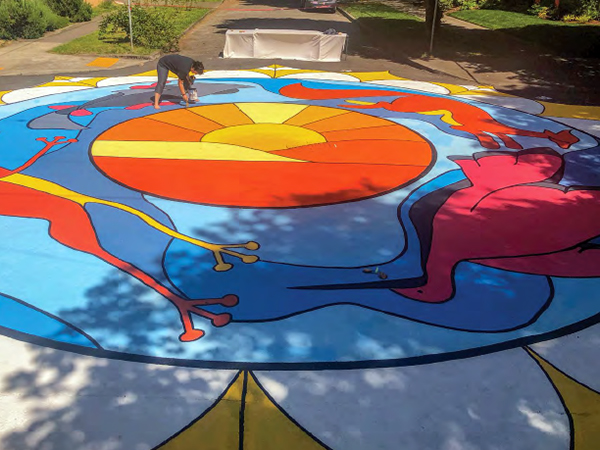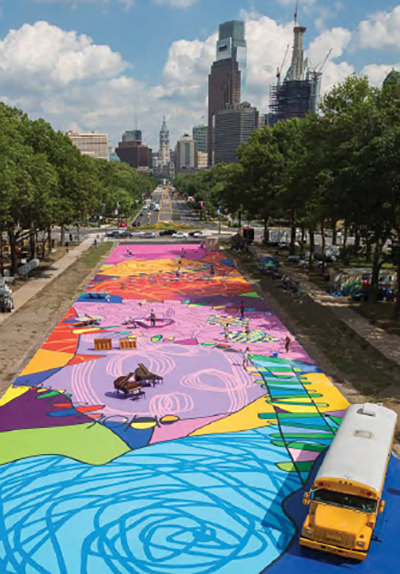
From the roof over our heads to the ground under our feet, asphalt plays an integral role in modern-day society. Beyond these practical uses, asphalt has come to serve as a tool to bring communities together, increase traffic safety and improve infrastructure across the U.S. as well as internationally.
In launching the asphalt art initiative, Bloomberg Philanthropies initiated a program to use asphalt in roadways as a canvas for artistic expression. This initiative aims to create beauty out of the ordinary. Communities have found that in using roadways as a canvas for art, they have been able to promote inclusivity while creating bright and welcoming spaces. Bloomberg Philanthropies has put forth a model illustrating how to plan, coordinate and execute projects with these goals in mind.
History
Asphalt art has become increasingly popular among communities looking to revitalize the places they call home. Much of the stimulus for these ventures comes from Michael Bloomberg’s revitalization projects done in New York during his time as mayor. In June 2020, Bloomberg Philanthropies established grants of $25,000 to 16 communities across the U.S. Following the success of the first round of grants, an additional 26 were created in 2021.
The overall goal of these grants was three-fold; Safety, Public Space and Community. When first considering safety, the main goals are to reduce the speed of vehicles in the target area and to decrease the number of accidents. With regards to public space, these projects aim to create a more positive perception of the site in question, as well as to make a space that is attractive to host events and visitors. Finally, the community facet of the project looks to involve those living in the areas in question by seeking their input on design and artists, all while creating a source of inspiration for those simply walking by.
Implementation
To successfully execute asphalt art initiatives, the main factors considered are budget, timeline, resources and materials. In determining a budget, cities need to decide on how much capital will be allocated to the project and if there is funding available, such as that offered by Bloomberg Philanthropies. Depending on the scale and resources allocated to the project, budgets of as little as $500 and as large as $250,000 have been implemented.
As an example, the city of Portland, Oregon transformed a once plain intersection into a piece of art with $500. In order to do this on such a slim budget, the design and labor were both provided by volunteers.

A larger-scale project that took place in Philadelphia turned a parking lot into a pop-up park for the summer months, covering eight acres of asphalt with paint. Including design materials and labor, this project clocked in at around $50,000.

The second factor to consider when implementing these projects is the timeline. Key factors in determining this would be to consider when traffic and circulation permit closing off these areas temporarily to execute the work. The third factor, resources, is also crucial to determine before getting a project started. Cities need to decide if the community will play a part if artists will be hired and if public works need to be involved and for what amount of time. To ensure the process runs smoothly, these key individuals need to be coordinated in advance.
Finally, the last aspect of these projects is to determine the materials that will be used. If the plan for the project is that the asphalt art should last several years, a runway grade thermoplastic would be ideal, as it is formulated to last up to 20 years. For an asphalt art installation that is only intended to be in place for weeks or months, exterior acrylic paint or driveway paint can do the trick.
Community feedback from these projects has been very positive. Residents report feeling safer and many say they have a greater appreciation for their neighborhoods. This initiative has demonstrated that when thinking outside the box, asphalt can have applications far beyond its conventional uses.
Theriault is a Supply Coordinator at Bitumar, Inc.
Sources:
Bloomberg Philanthropies. “Asphalt Art Guide” 2022
“Asphalt Doesn’t Always have to be Black” November 8, 2019
Calacal, Celisa. “Across Kansas City, asphalt art is paving the way for Safer Streets”
Images by Greg Raisman, Steve Weinik and Maxwell Zengaga














